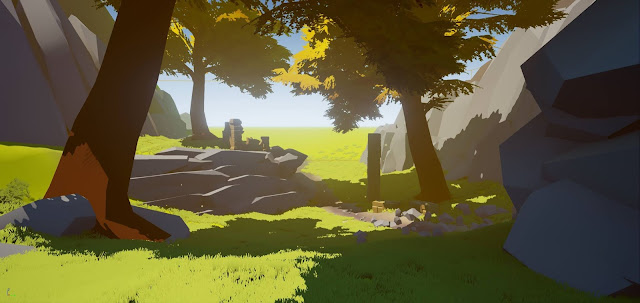As we're
putting the final touches to our game before the end of the project, it's time
we talk about Remembrance's approach to storytelling and how it has evolved
during the course of our development. I'm Isak Arbman, I work as the lead game
writer on Remembrance, and it's my responsibility that every aspect of the
game's design is in line with and complements the game's narrative. Because we
decided early on that Remembrance was not going to tell its story through
dialogue or text, our work as game writers has been focused more on
worldbuilding. But we have also done a lot of traditional writing, like a
backstory and even screenplays.
In our
group, the writing is what is supposed to inspire the other creative
disciplines when they create their content. We write environmental descriptions
for our graphics artists to base their art on, as well as screenplays to
inspire the sound design team who are responsible for conveying the backstory
through their work. The work we put into the game is very much indirect, seeing
as how there is no actual text in the game. We lay the foundation for all the
assets that make up Remembrance.
When the
project started, all we had was a basic concept of what the game was supposed
to be, but there was no real jumping-off point when it came to the story. We
had to start with defining the main character and the world in which the game
takes place. Remembrance is set in an abandoned world, so we created a backstory
for why it was abandoned. The main character uses mysterious powers to navigate the environment, so we tied the
character into the backstory and explained these powers. After
that we were all able to create a context for what you are trying to do in the
game. We figured you would have to collect something, but what was not
clear. We decided it would have to be tied to the story somehow, but the
challenge lay in not using images or the written word. This is where the idea
for “soundscapes” came into play. They are a sort of flashback sequence that
will activate when you enter special areas in the game world, told entirely
with sound-effects. It was really important that these soundscapes did not
include voice acting, as the characters that inhabited this world do not
communicate the way we do. We do have sounds that are meant to sound humanoid,
however, to convey emotion in the scenes, like screams to convey fright.
As we are
preparing to finally present our game, I reflect on what an interesting
experience it has been to work as a game writer for a game like Remembrance. It
was a welcome challenge for me to work on a game that truly made me think
differently about my approach to writing and how it would affect the game. It
has given me so much experience that I feel will help me a lot moving forward.
- Isak
- Isak








